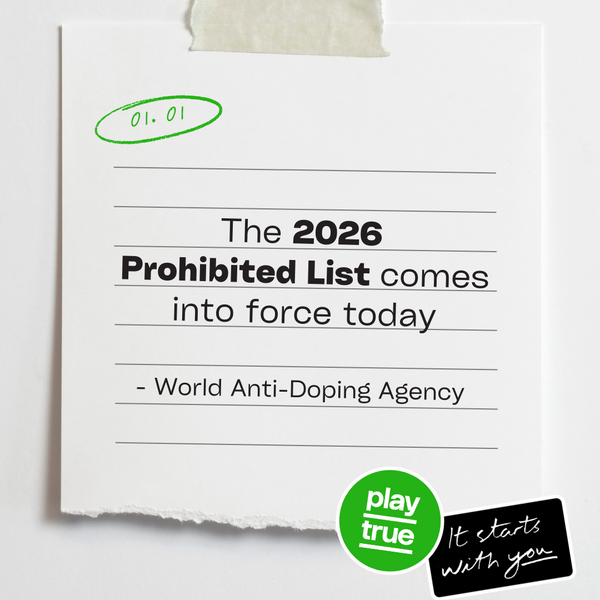Releases
WADA publishes redesigned, more athlete-friendly, 2021 Prohibited List

Agency calls on athletes and all stakeholders to note List modifications concerning substances and methods
The World Anti-Doping Agency (WADA) publishes today the 2021 List of Prohibited Substances and Methods (List); the 2021 Summary of Major Modifications and Explanatory Notes; and the 2021 Monitoring Program. The 2021 List, which has been redesigned in order to improve navigation and usability for athletes and their support personnel, was approved by WADA’s Executive Committee (ExCo) during its meeting on 14-15 September 2020 and comes into force on 1 January 2021.
The List is one of the International Standards that are mandatory for all Signatories of the World Anti-Doping Code (Code). It designates what substances and methods are prohibited both in- and out-of-competition and which substances are banned in particular sports.
WADA Director General Olivier Niggli said: “WADA is pleased to publish the 2021 Prohibited List in its newly designed format; which, we believe, will be easier for athletes and their entourage to navigate. We kindly ask athletes, their entourage and all stakeholders to review the List carefully and to take particular note of this year’s modifications to avoid inadvertent use of substances and methods that are prohibited in sport for 2021.”
“Every year, the List undergoes extensive consultation involving some of the most qualified experts in the fields of science and medicine, including chemistry, endocrinology, haematology and pharmacology. This helps to ensure that any substance or method that may provide performance enhancement, or that may negatively impact athlete health or the spirit of sport, are considered in a timely manner so as to maintain a level playing field for clean athletes.”
2021 List Redesign
As it relates to the List’s redesign, the improvements include:
- A table of contents that provides a non-exhaustive list of examples of medical conditions for which substances in the different classes may be prescribed;
- An introduction that defines some terms used in the List;
- Headings in each class indicating which substances or methods are prohibited at all times or in-competition, which classes are specified versus non-specified, and, where applicable, identification of the substances of abuse within a class;
- Well-defined headings for the classes and sub-classes;
- Exceptions and notes within categories that are now more clearly identified; and
- A new index at the end of the document, listing the substances and methods mentioned in the List.
Major Modifications
As it relates to modifications, the major ones are outlined below:
- Substances of abuse: During the two-year review process for the 2021 version of the Code, WADA received considerable stakeholder feedback related to substances of abuse where it was felt that the use of some substances included in the List was often unrelated to sport performance. Accordingly, Article 4.2.3 was added to the Code, and cocaine, diamorphine (heroin), methylenedioxymethamphetamine (MDMA/“ecstasy”) and tetrahydrocannabinol (THC) have been identified as substances of abuse in the 2021 List. This means that if an athlete can demonstrate that the use of any of these four substances was out-of-competition and unrelated to sport performance, the suspension imposed will now be three months and may be reduced to one month if the athlete completes a drug rehabilitation program.
- Prohibited Method M2.2: Chemical and physical manipulation: In accordance with the newly introduced Article 4.2.2 in the 2021 Code, it will now be possible to identify a prohibited method as “specified”. Accordingly, intravenous infusions and/or injections of more than a total of 100 mL per 12-hour period, except for those legitimately received in the course of hospital treatments, surgical procedures or clinical diagnostic investigations, have now been classified as “specified”. This means that an athlete may receive a reduced sanction if it can be proven that this method was not used for doping purposes.
Meanwhile, implementation of the following major modification to the List will come into force on 1 January 2022:
- Glucocorticoids: The draft 2021 List, which was considered by WADA’s ExCo during its September 2020 meeting, proposed prohibiting all injectable routes of administration of glucocorticoids in-competition. While this modification was approved, the ExCo asked WADA Management to implement the prohibition on 1 January 2022, to allow enough time for broad communication and education of athletes, their entourage and medical personnel so that there is a better understanding of the practical implementation of washout periods to avoid inadvertent Adverse Analytical Findings. It will also allow WADA-accredited laboratories the time to update their procedures to incorporate the revised and substance-specific reporting values; and, for sports authorities to develop educational tools for athletes, and for medical and support personnel to address the safe use of glucocorticoids for clinical purposes within anti-doping.
List Review Process
Every year, the List’s revision process is led by WADA, beginning with an initial meeting in January and concluding with the publication of the List by 1 October. This is an extensive consultation process that includes WADA’s List Expert Group gathering information including the latest scientific and medical research, trends, and intelligence gathered from law enforcement and pharmaceutical companies; circulating a draft List among stakeholders; taking their submissions into consideration and revising the draft, followed by review by the Agency’s Health, Medical and Research (HMR) Committee. The HMR Committee then makes its recommendations to the WADA ExCo, which approves the List during its September meeting.
For a substance or method to be added to the List, it must be determined that it meets at least two of the following three criteria:
- It has the potential to enhance or enhances sport performance
- It represents an actual or potential health risk to the athletes
- It violates the spirit of sport
The List is released three months ahead of it taking effect so that athletes and their entourage can acquaint themselves with any modifications. Ultimately, athletes are responsible for prohibited substances found in their body and prohibited methods found to have been used. Athlete entourage are also liable for Anti-Doping Rule Violations if determined to be complicit. Consequently, if there is any doubt as to the status of a substance or method, it is important that they contact their respective Anti-Doping Organization (International Federation or National Anti-Doping Organization) for advice.
It should be noted that for athletes who have a legitimate medical reason for using a prohibited substance or method that is on the List, they may be accommodated if they meet the criteria outlined in the International Standard for Therapeutic Use Exemptions (ISTUE). The TUE Program is a rigorous and necessary part of elite sport which has overwhelming acceptance from athletes, physicians and anti-doping stakeholders.
Upcoming Webinar
In order to assist stakeholders in their understanding and implementation of the 2021 List, WADA will host a webinar on 29 October 2020 at 7:00 AM EDT entitled: 2021 Prohibited List and beyond. Participants will be taken through the major modifications; as well as, a few key items under review for 2022 by WADA’s List Expert Group. Stakeholders wishing to register for the webinar are invited to do so here.
Languages and Formats
The 2021 Prohibited List; the 2021 Summary of Modifications and Explanatory Notes; and the 2021 Monitoring Program are available for download on WADA’s website in English and French with Spanish to follow in the coming weeks.
Stakeholders wishing to translate the List into other languages are kindly asked to signal their interest to info@wada-ama.org, by 30 October 2020. WADA would then provide the necessary files and, once the translation is finalized, would make the List available on the Agency’s website.
The List’s mobile-friendly digital edition will go live on 1 January 2021.

